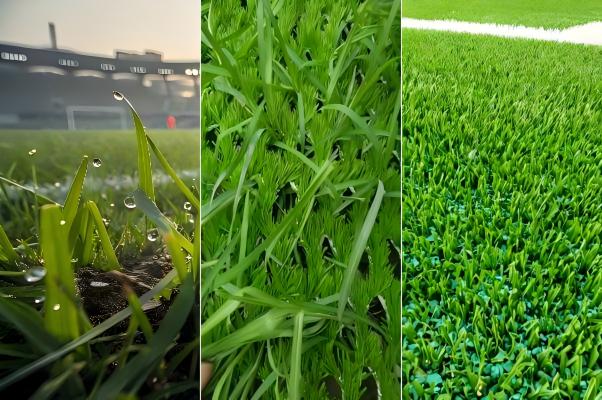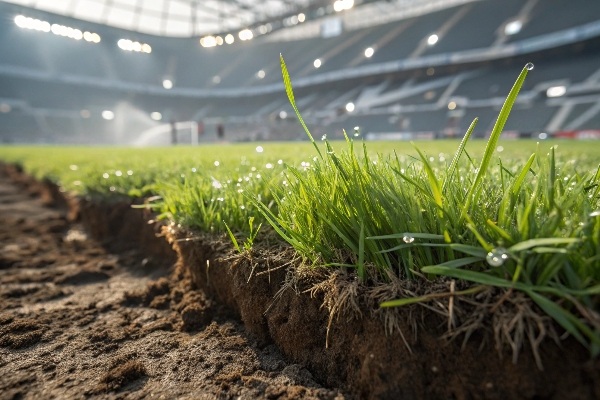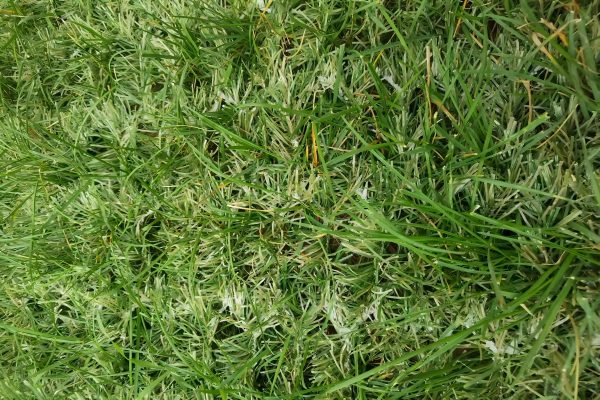Choosing a football field surface is a huge decision. A wrong move costs you money and performance. This guide will help you understand the main options clearly and simply.
The three main football field surfaces are natural grass, artificial grass, and hybrid turf. Natural grass is traditional but high-maintenance. Artificial grass is durable and versatile. Hybrid turf combines attributes of both for elite performance, often at a higher cost. The best choice depends on your specific needs.

Understanding the details of each type is the first step toward making a smart investment for your project. As an engineer in this industry for many years, I’ve seen how the right surface can make or break a facility. It’s not just about looks; it’s about performance, safety, and your budget. Let’s break down each option so you can find the best fit for your needs and achieve greater success with your sports facility.
What is Natural Grass?
We all love the look and feel of a perfect natural grass field. But the endless costs and work required to keep it that way can be a serious headache.
Natural grass1 is the classic playing surface, grown directly from seed or laid as sod. It offers excellent playability and a traditional feel that many players prefer. However, it requires a lot of water, mowing, fertilizing, and rest between games, making it a challenge for heavy use.

Natural grass has been the standard for football for over a century. When it’s in perfect condition, nothing feels better underfoot. The ball reacts predictably, and players often feel more comfortable sliding and tackling. I remember a client who insisted on natural grass for his new training facility because his players demanded it. They loved the field for the first few months. However, the reality of its maintenance soon became a problem.
The Demands of a Living Surface
The biggest challenge with natural grass is that it’s a living thing. It’s sensitive to weather, disease, and heavy use. You can’t just install it and forget about it. It needs a dedicated grounds crew and a significant budget for upkeep.
| Aspect | Pros | Cons |
|---|---|---|
| Playability | Excellent ball roll, authentic feel. | Performance can be inconsistent due to weather (mud, bare spots). |
| Player Safety | Softer surface, lower surface temperature. | Divots and uneven ground can increase injury risk. |
| Maintenance | Environmentally friendly (when managed well). | High water usage, frequent mowing, fertilizing, and pest control. |
| Durability | Self-repairing to a degree. | Limited playing hours; needs recovery time after games. |
| Cost | Lower initial installation cost. | Very high long-term maintenance costs. |
My client in that dry region quickly found his water bills and labor costs soaring. The field could only be used for a few hours a day before it needed to rest, which limited his revenue. He learned the hard way that while natural grass is beautiful, it’s not always the most practical choice for a business that needs to maximize playing time.
What is Artificial Grass?
People have strong opinions about artificial grass. Is it a low-cost, durable solution or just a cheap plastic carpet? The truth has changed a lot over the years.
Artificial grass2 is a synthetic surface made from plastic fibers designed to look like real grass. It sits on a backing material and is usually filled with sand and rubber granules. Its main advantages are extreme durability, very low maintenance, and all-weather usability.

When I first started my career working in a turf manufacturing workshop, the products were simple and, honestly, quite rough. They were more like green carpets than playing surfaces. But the technology has improved dramatically. Today’s third-generation (3G) artificial turf is an engineered system designed for high performance and safety. It’s what I specialize in every day, helping clients choose the right specifications to ensure they get a product that lasts and performs well.
An Engineered Playing Surface
Modern artificial turf consists of three main parts: the yarn (the "grass" blades), the backing (which holds the yarn), and the infill (usually sand and rubber, which provides stability and shock absorption).
| Factor | Artificial Grass | Natural Grass |
|---|---|---|
| Durability | Extremely high; can be used 24/7. | Low; requires recovery time. |
| Maintenance | Low; needs periodic brushing and infill top-up. | High; daily/weekly mowing, watering, fertilizing. |
| Weather | All-weather performance; excellent drainage. | Poor in heavy rain (mud) or drought (hard ground). |
| Consistency | Perfectly uniform and consistent playing surface. | Can have bare spots, weeds, and lumps. |
| Cost | Higher initial investment. | Much lower long-term maintenance costs. |
I’ve helped many customers switch from natural grass to artificial turf, and the primary reason is almost always about increasing playing hours. A school, for example, can use its artificial field for football practice, soccer games, and physical education classes all in the same day, regardless of the weather. This level of use is simply impossible on natural grass. It turns a cost center into a potential source of revenue.
What is Hybrid Turf?
Stuck between the classic feel of grass and the heavy-duty resilience of turf? This indecision can feel risky. But what if you could have the best of both worlds?
Hybrid turf3 is a high-performance playing surface that mixes natural grass with synthetic fibers. The artificial fibers reinforce the natural grass roots, making the field much stronger. It aims to provide the feel of natural grass with the durability closer to artificial turf.

Hybrid turf represents the top tier of sports surfaces. It’s the solution chosen by most major professional stadiums around the world, from the English Premier League to the NFL. I have consulted on a few high-profile projects where the budget was large enough to consider this option. The goal for these clients is always the same: give players the perfect natural surface they love, but ensure the field can withstand a packed schedule of games and events without turning into a mess.
The Best of Both Worlds
There are two main types of hybrid systems. One involves stitching millions of synthetic fibers deep into the soil of a natural grass pitch. The other uses a carpet-like base with synthetic fibers, and the natural grass grows up through it. Both methods create an incredibly stable and durable surface.
| Feature | Description |
|---|---|
| Strength | The synthetic fibers anchor the grass roots, preventing divots and wear. The surface remains stable even under intense use. |
| Playability | It plays exactly like a perfect natural grass field because it’s about 95% natural grass. Players love it. |
| Durability | It can handle three times more playing hours than a 100% natural grass field. It also recovers much faster after a game. |
| Maintenance | Still requires the full maintenance of a natural grass pitch (mowing, watering), so the costs are high. It’s a premium product with premium upkeep. |
| Cost | The initial installation cost is the highest of all three options, often double or triple that of a standard artificial turf field. |
This option is not for everyone. It is a major investment. But for a professional club or a multi-use stadium that hosts concerts and other events, the ability to have a pristine, natural-playing surface that bounces back quickly is worth the price.
Conclusion
Natural grass, artificial turf, and hybrid systems each serve a purpose. The best choice depends on your budget, planned usage hours, and climate, a decision we help our customers make.
-
Explore the advantages of natural grass, including its playability and traditional feel, which many players prefer. ↩
-
Learn about the benefits of artificial grass, including low maintenance and durability, making it a popular choice for many facilities. ↩
-
Discover how hybrid turf combines the best of natural grass and artificial fibers for a high-performance playing surface. ↩
_画板-1.png)
_画板-1.png)